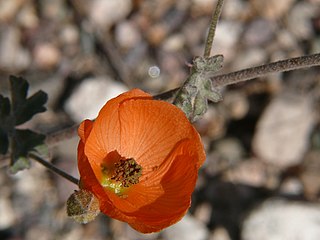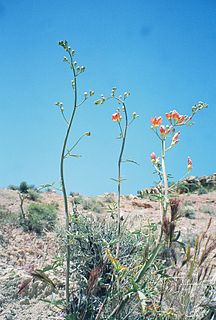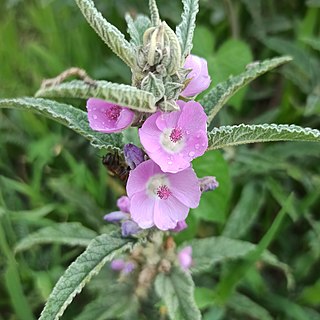Mallow or mallows may refer to:

Sphaeralcea is a genus of flowering plants in the mallow family (Malvaceae). There are about 40-60 species, including annuals, perennials, and shrubs. Most originate in the drier regions of North America, with some known from South America. They are commonly known as globemallows, globe mallows, or falsemallows. The name of the genus is derived from the Greek words σφαῖρα (sphaira), meaning "sphere," and αλκεα (alkea), meaning "mallow."

Guarea is a genus of evergreen trees or shrubs in the family Meliaceae, native to tropical Africa and Central and South America. At their largest, they are large trees 20–45 m tall, with a trunk over 1 m diameter, often buttressed at the base. The leaves are pinnate, with 4–6 pairs of leaflets, the terminal leaflet present. They are dioecious, with male and female flowers on separate plants. The flowers are produced in loose inflorescences, each flower small, with 4–5 yellowish petals. The fruit is a four or five-valved capsule, containing several seeds, each surrounded by a yellow-orange fleshy aril; the seeds are dispersed by hornbills and monkeys which eat the aril.
Sphaeralcea incana, with the common names gray globemallow and soft globemallow, is a desert plant in the mallow family (Malvaceae).
Desert mallow is a common name for several plants and may refer to:
Sphaeralcea laxa, with the common name caliche globemallow, is a desert plant in the mallow family (Malvaceae).

Sphaeralcea ambigua, is a species of flowering plant commonly known as desert globemallow or apricot mallow, is a member of the genus Sphaeralcea in the mallow family (Malvaceae).

Eremalche exilis is a species of flowering plant in the mallow family known as white mallow or desert mallow. It is native to Baja California, Mexico and the southwestern United States where it grows in desert and other dry scrub habitats.

Sphaeralcea gierischii, Gierisch's globemallow or Gierisch mallow, is an endangered species of flowering plant in the mallow family, Malvaceae. It is native to the western United States, where it is known only from Utah and Arizona. It was described in 2002.

Sphaeralcea angustifolia is a species of flowering plant in the mallow family known by the common names copper globemallow and narrow-leaved globemallow. It is native to the southwestern United States as well as northern and central Mexico, where it grows in desert and plateau habitat. It produces many erect stems, approaching three meters in maximum height. It is woolly or felt-like in texture. The gray-green leaf blades are lance-shaped and measure up to about 5 cm long. They have wavy or slightly lobed edges. The leafy inflorescence bears several flowers each with five wedge-shaped orange petals just under 1 cm in length, and yellow anthers.

Sphaeralcea coulteri is a species of flowering plant in the mallow family known by the common name Coulter's globemallow. It is native to the Sonoran Desert, its distribution extending from northern Mexico north into California and Arizona. It is an annual herb, its slender, hairy stems sprawling or growing erect to a maximum height near 1.5 meters. The thin, gray-green leaf blades are wide and short, heart-shaped or triangular in shape, and measure up to about 5 centimeters long. They have a few wide lobes along the edges which may have teeth or smaller lobes. The leafy inflorescence bears clusters of flowers each with five wedge-shaped orange petals around a centimeter long, and yellow anthers.

Sphaeralcea emoryi is a species of flowering plant in the mallow family known by the common name Emory's globemallow. It is native to the Southwestern United States, California and Northwestern Mexico. It grows in desert habitat and sometimes disturbed areas such as roadsides.

Sphaeralcea grossulariifolia is a species of flowering plant in the mallow family known by the common name gooseberryleaf globemallow. It is native to the western United States, where it can be found in the Great Basin and surrounding regions. It grows in sagebrush, woodlands, playas, and the canyons of the upper Colorado River. It is common in disturbed areas, such as habitat recently cleared by wildfire.

Sphaeralcea munroana is a species of flowering plant in the mallow family known by the common names Munro's globemallow and Munro's desert-mallow. It is native to the western United States, where it can be found in the Great Basin and surrounding regions. It grows in sagebrush, desert flats, mountain slopes, and requires plenty of sunlight to thrive. This perennial herb produces erect stems up to about 80 centimetres (31 in) tall from a thick root system. It is woolly and gray-green in color. The alternately arranged leaves have triangular blades up to 6 cm long, usually edged with large lobes and a toothed margin. Flowers occur in clusters on a raceme-like inflorescence. The flower has five apricot to red-orange petals each just over 1 cm long.

Sida hermaphrodita, known by the common names Virginia fanpetals and Virginia mallow, is a perennial forb native to the eastern United States, which produces white flowers in summer.
Primula rusbyi is a species of Primula. A common name is Rusby's primrose.
Brickellia rusbyi, the stinking brickellbush, is a North American species of flowering plants in the family Asteraceae. It is native to northern Mexico and the southwestern United States.
Hymenoxys rusbyi is a North American species of flowering plant in the daisy family known by the common names Rusby's rubberweed or Rusby's bitterweed. It has been found only in the states of Arizona and New Mexico in the southwestern United States.
Isocoma rusbyi, the Rusby's goldenbush, is a North American species of plants in the family Asteraceae. It has been found in the States of Arizona, Utah, New Mexico, and Colorado in the southwestern United States. Some of the populations lie inside Grand Canyon and Petrified Forest National Parks, others in the Glen Canyon National Recreation Area.











